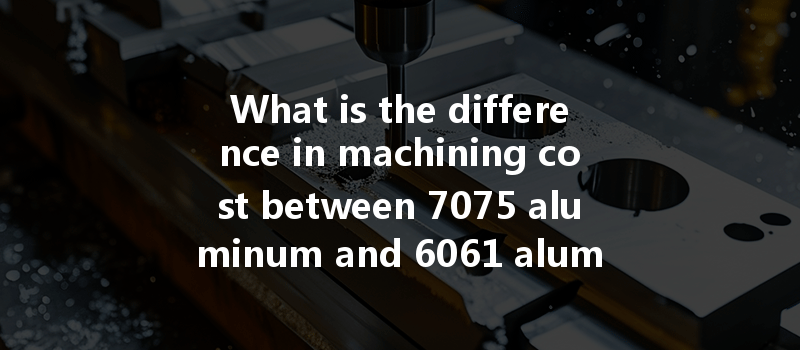Have you ever wondered why certain materials are chosen for specific machining projects over others? Think about it: two types of aluminum, like 7075 and 6061, can have drastically different machining costs, yet both are widely used across various industries. In fact, did you know that the cost of machining aluminum can vary anywhere from $50 to $200 per hour depending on the alloy, design complexity, and machine type? Understanding the nuances between these materials is crucial not only for manufacturers but also for engineers and product developers.
In this exhaustive guide, we will delve deep into the machining costs associated with 7075 aluminum and 6061 aluminum in CNC turning. We’ll look at their mechanical properties, machining characteristics, and the factors influencing their costs, providing you with the knowledge needed to make informed decisions for your CNC machining projects.
Aluminum is one of the most versatile metals available today. Comprising various alloys, each type offers distinct properties suitable for different applications. Two of the most popular aluminum alloys are 7075 and
1.1 6061 Aluminum
6061 aluminum is known for its excellent corrosion resistance and good weldability, making it ideal for structural applications. Its mechanical properties include:
1.2 7075 Aluminum
On the other hand, 7075 aluminum boasts exceptional strength, often compared to that of steel. It is a cold-treated forging alloy and is commonly used in aerospace applications. Its properties include:
The cost of machining aluminum varies not only by the type of alloy but also by several other factors.
2.1 Material Costs
7075 aluminum is generally more expensive than 6061 due to its higher strength and enhanced performance characteristics. A rough cost comparison reveals:
Higher material costs directly impact machining expenses and influence pricing models for products manufactured using 7075 aluminum.
2.2 Machining Complexity
The complexity of the design can influence CNC machining costs significantly. More intricate designs require additional machining hours and sophisticated tooling, which drives up costs.
Example: A simple flat plate made from 6061 aluminum may take 1 hour to machine, while a complex part made from 7075 could require 3 to 4 hours.
2.3 Tooling and Setup Costs
7075 aluminum is tougher to machine than 6061 due to its higher strength. This often necessitates the use of specialized cutting tools, which can have a higher upfront cost. Furthermore, the setup time for machining 7075 can be longer, impacting the cost per part.
Understanding how each material behaves during the CNC turning process is essential for effective machining.
3.1 Cutting Tools

When machining 6061 aluminum, standard carbide tooling usually suffices. In contrast, machining 7075 often requires high-quality coated tools to withstand the additional wear and heat produced during the process.
3.2 Machining Speed
6061 aluminum allows for higher feed rates and spindle speeds, which speeds up production timelines. In contrast, 7075 requires slower feeds and meticulous attention to detail, increasing machining time.
Choosing between 7075 and 6061 can have significant economic implications for manufacturers. These include:
5.1 Aerospace Applications
In the aerospace industry, where strength-to-weight ratios are crucial, engineers often prefer 7075 aluminum. However, the increased production costs can become prohibitive for non-critical components.
Case Study: A manufacturer tasked with producing bulk aluminum fuselage parts found that using 6061 aluminum cut production costs by 20% while still meeting safety and regulatory requirements.
5.2 Automotive Manufacturing
Automotive applications leverage both alloys depending on the specific needs. For performance-oriented components, 7075 is popular, while 6061 is often chosen for non-load-bearing structures.
Case Study: An automotive company developing a lightweight electric vehicle initially opted for 7075 but switched to 6061 to reduce machining time and costs, ultimately saving $100,000 on the production run.
To optimize machining costs associated with these two alloys, consider the following strategies:
6.1 Process Optimization
Utilizing advanced software to plan machining processes can minimize waste and optimize tool paths, effectively reducing machining times and costs.
6.2 Material Specification
Avoid over-specifying materials. Choose the alloy based on the performance requirements of the part. If high-strength aluminum isn’t necessary, opting for 6061 can significantly cut costs.
6.3 Tool Selection
Invest in high-quality cutting tools appropriate for the material being machined. More durable tools may have a higher upfront cost but save money in the long run through increased lifespan and reduced machining time.
Understanding the differences in machining costs between 7075 aluminum and 6061 aluminum CNC turning is vital for businesses aiming to balance quality with cost-effectiveness. Each alloy has its own set of advantages and considerations that impact machining operations, from material costs to tooling requirements and overall production timelines.
In summary, this blog serves as a pivotal guide for engineers, manufacturers, and product developers to contemplate the financial and operational implications of material selection in CNC turning. By considering the specific requirements of each application and employing sound machining strategies, it is possible to reduce costs while maintaining high quality in manufacturing.
As you navigate your future projects, remember: the decision between 6061 and 7075 aluminum can significantly influence not only your machining costs but also the success of your product in the competitive market landscape. Be thoughtful in your material choices, and always strive for efficiency in every turn of the CNC machine!
Related Posts
- How can CNC custom processing factories improve processing efficiency through technical improvements in manufacturing?
- What Is the Difference Between 6061 Aluminum CNC Machining and ABS Plastic CNC Machining?
- What Best Practices Should Be Followed for Part Design Based on Material Properties in CNC Machining?






